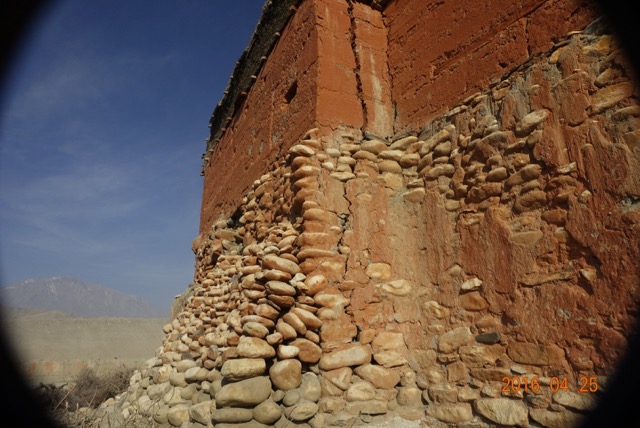From 1380 to 2008, the upper Mustang valley was ruled by a single dynastic line. Six hundred twenty eight years is a long time for political stability; what led to this continuous succession within one family over 24 generations?
In the mid 14th century, the villages of Mustang were much the same as now, but each was a separate fiefdom. They were widely separated, a half-day’s walk apart at best, and the efforts at daily sustenance left little time or energy for warring between neighbors.
Missionaries from the north brought new forms of Buddhism to the isolated valleys between the Himalayas and Tibet. There is little to no written history from that era, but a book discovered in the monastery at Tsarang by Michel Peissel provided a list of the Mustang monarchs, starting with Ame Pal, who lived at the end of the 1300s. His descendants then ruled as kings until the government of Nepal abolished the local monarch in 2008.
So how did life remain so stable here for so long? Of course, the geography plays an outsized role. Mustang is about 50 miles wide in most directions, rimmed by a mountain crest no lower than 15,000 feet in its entirety, except for the small area through which the Kali Gandaki flows south to India. Mustang was lucky to be so isolated, and in addition almost surrounded by unaggressive sparsely populated Tibet.
Little rain falls here; total annual precipitation is about 10 inches of water equivalent, mostly as snow in the winter. So the area can only support about 10,000 people at most, and even some of them leave during the winter months for warmer parts lower down. The populace can only survive by a combination of crops irrigated from the meagre mountain snowmelt, and animals who must be shepherded miles every day to forage the sparse grass.
Despite these restrictions, families might still outgrow their agricultural plots. The Mustangi followed a strict inheritance protocol to prevent farms from being divided. First born sons got all the land; second born were sent to monasteries at age 9, and subsequent boys became shopkeepers or shepherds. This provided a micro level of stability preventing squabbles over land within and between families.
The dominant religion, an older form of Tibetan Buddhism, emphasizes peace and harmony amongst all living creatures. The tight connection most families have with the keepers of that faith, the monks, has allowed that sensibility to permeate the population.
Finally, and maybe most important, the royal family did not engage in succession squabbles. Kings, starting with Ame Pal, routinely stepped down before they became decrepit in mind or body, having early on appointed a successor son or nephew. The younger generation assumed their time would come while they were still robust enough to enjoy it.
On our fourth day, we trekked 11.4 miles, 4275’ of elevation gain, 6 hours from Gheling to Tsarang. Reminders of the stable past are still very much present in Mustang. It’s only been in the last 20-30 years that modern change has filtered in. When I first got with the idea of traveling here, reading Heinrich Harrar’s Seven Years in Tibet, I became enamored with his description of the meagre diet, consisted mainly of the barley-based Tsampa, and “rancid yak butter tea.” For thirty years, I’d longed to try these primitive delicacies. I quickly became disabused with that romantic ideal. In Gheling, I tried both for breakfast, and quickly switched back to the more modern pancakes and lemon/ginger teabags on offer.
Leaving Gheling, our first hour took us 1400’ up to 13,100 to Nyi La, across the by now familiar terrain of rock, dirt and occasional grassy clumps. On a bluff overlooking town, a cluster of red-walled monastery buildings stood silent guard; all the monks were still down in Pokhara or Kathmandu, waiting another week or so to return for the summer. From the top of the pass, the trail we had followed through the snow the evening before into town looked impossibly steep.
For lunch, we almost literally rolled down into Ghemi. The trail dropped at a precipitous 25-30% grade, filled with small round stones which had not yet reached their angle of repose.
Outside of town, the longest mani wall in Mustang, now abandoned, stood empty of prayer wheels.
Maybe that’s why, before leaving, Chaim and our porter, Pasang, had methodically spun every one set within the smaller wall near the tiny monastery.
On our way to the second major pass of the day, Chinggel La (12,850’), the route forked off to Dhakmar. Flanked between a large wind cave and fluted red rock spires, a weathering cluster of Chortens stood guard, beckoning us that way.
Our route led the other direction, towards Tsarang, the second city of Mustang. 1000’ lower than the capital of Lo, it had served as the cold season headquarters of the royal family. The winter palace, damaged by last year’s earth quake, had split a major sustaining wall, and we would not be entering.
But the local monastery was welcoming, and we looked forward to a tour in the morning.





